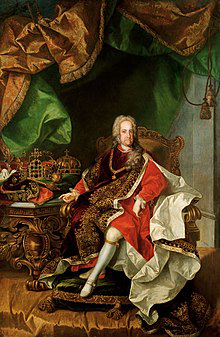

Count of Hainaut
1 October 1685 Hofburg Palace, Vienna
20 October 1740(1740-10-20) (55) Palais Augarten, Vienna
NamesGerman: Karl Franz Joseph Wenzel Balthasar Johann Anton Ignaz
18th century Habsburg Holy Roman Emperor Charles VICharles VI wearing the Order of the Golden Fleece, to his right the Imperial Crown of the Holy Roman Empire, Hungarian Crown of Saint Stephen, Bohemian Crown of Saint Wenceslas, and the Austrian Archducal hat as symbols of his realms (painting by Martin van Meytens, circa 1730s) Holy Roman Emperor King of Naples 1707–1735 King of Sardinia 1708–1720 King of Hungary 1711–1740 King of Croatia 1711–1740 King of Serbia 1718-1739 King of Bohemia 1711–1740 King of Sicily 1720–1735 Archduke of Austria 1711–1740 Duke of Teschen 1711–1722 Duke of Luxembourg 1714–1740 Duke of Parma and Piacenza 1735–1740 Duke of Guastalla 1735–1740 Duke of Brabant 1714–1740 Duke of Limburg 1714–1740 Duke of Lothier 1714–1740 Duke of Milan 1714–1740 Count of Namur 1714–1740 Count of Flanders 1714–1740 Count of Hainaut 1714–1740 Reign12 October 1711 – 20 October 1740 Coronation22 December 1711, FrankfurtPredecessorJoseph ISuccessorCharles VIIBorn(1685-10-01 ) 1 October 1685 Hofburg Palace, ViennaDied20 October 1740(1740-10-20) (aged 55) Palais Augarten, ViennaBurialImperial CryptSpouseElisabeth Christine of Brunswick-Wolfenbüttel (m. 1708)Issue Detail Leopold Johann Maria Theresa, Holy Roman Empress Archduchess Maria Anna Archduchess Maria Amalia HouseHabsburgFatherLeopold I, Holy Roman EmperorMotherEleonor Magdalene of NeuburgReligionRoman CatholicismSignature Charles VI (German: Karl; Latin: Carolus; 1 October 1685 – 20 October 1740) was Holy Roman Emperor and ruler of the Austrian Habsburg Monarchy from 1711 until his death, succeeding his elder brother, Joseph I. He unsuccessfully claimed the throne of Spain following the death of his relative, Charles II. In 1708, he married Elisabeth Christine of Brunswick-Wolfenbüttel, by whom he had his four children: Leopold Johann (who died in infancy), Maria Theresa (the last direct Habsburg sovereign), Maria Anna (Governess of the Austrian Netherlands), and Maria Amalia (who also died in infancy). Four years before the birth of Maria Theresa, faced with his lack of male heirs, Charles provided for a male-line succession failure with the Pragmatic Sanction of 1713. The Emperor favoured his own daughters over those of his elder brother and predecessor, Joseph I, in the succession, ignoring the decree he had signed during the reign of his father, Leopold I. Charles sought the other European powers' approval. They demanded significant terms, among which were that Austria close the Ostend Company. In total, Great Britain, France, Saxony-Poland, the Dutch Republic, Spain, Venice, States of the Church, Prussia, Russia, Denmark, Savoy-Sardinia, Bavaria, and the Diet of the Holy Roman Empire recognised the sanction. France, Spain, Saxony-Poland, Bavaria and Prussia later reneged. Charles died in 1740, sparking the War of the Austrian Succession, which plagued his successor, Maria Theresa, for eight years.

We use cookies
We use cookies and other tracking technologies to improve your browsing experience on our website, to show you personalized content and targeted ads, to analyze our website traffic, and to understand where our visitors are coming from. Privacy Policy.